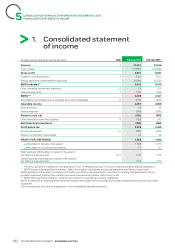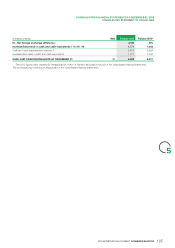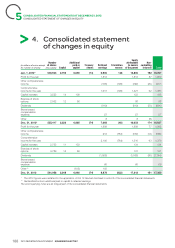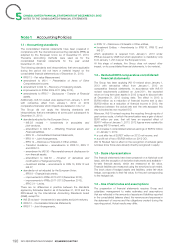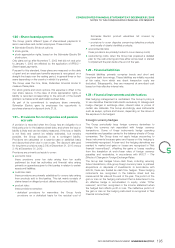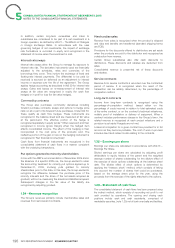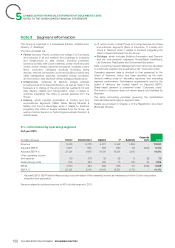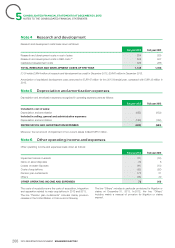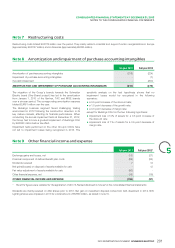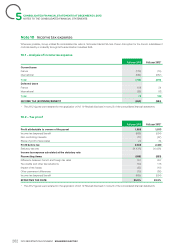APC 2013 Annual Report Download - page 194
Download and view the complete annual report
Please find page 194 of the 2013 APC annual report below. You can navigate through the pages in the report by either clicking on the pages listed below, or by using the keyword search tool below to find specific information within the annual report.
5CONSOLIDATED FINANCIALSTATEMENTS ATDECEMBER 31, 2013
NOTES TO THE CONSOLIDATED FINANCIAL STATEMENTS
Intangible assets are amortized on a straight-line basis over their
Software implementation
useful life or, alternatively, over the period of legal protection. External and internal costs relating to the implementation of
Amortized intangible assets are tested for impairment when there enterprise resource planning (ERP) applications are capitalized
is any indication that their recoverable amount may be less than when they relate to the programming, coding and testing phase.
their carrying amount. They are amortized over the applications’ useful lives. In
Amortization and impairment losses on intangible assets accordance with paragraph98 of IAS38, the SAP bridge
acquired in a business combination are presented on a separate application currently being rolled out within the Group is
statement of income line item, “Amortization and impairment of amortized using the production unit method to reflect the pattern
purchase accounting intangibles”. in which the asset’s future economic benefits are expected to be
consumed. Said units of production correspond to the number
Trademarks
of users of the rolled-out solution divided by the number of target
Trademarks acquired as part of a business combination are not users at the end of the roll-out.
amortized when they are considered to have an indefinite life.
Property, plant and equipment1.10 –
The criteria used to determine whether or not such trademarks
have indefinite lives and, as the case may be, their lifespan, are
as follows: Property, plant and equipment is primarily comprised of land,
buildings and production equipment and is carried at cost, less
brand awareness,
l
accumulated depreciation and any accumulated impairment
outlook for the brand in light of the Group’s strategy for
l
losses, in accordance with the recommended treatment in
integrating the trademark into its existing portfolio. IAS16– Property, plant and equipment.
Non-amortized trademarks are tested for impairment at least
Each component of an item of property, plant and equipment
annually and whenever there is an indication they may be
with a useful life that differs from that of the item as a whole is
impaired. When necessary, an impairment loss is recorded.
depreciated separately on a straight-line basis. The main useful
Internally-generated intangible assets lives are as follows:
Buildings:
l20 to 40 years;
Research and development costs
Machinery and equipment:
l3 to 10 years;
Research costs are expensed in the statement of income when Other:
l3 to 12 years.
incurred.
Systems were set up to track and capitalize development costs The useful life of property, plant and equipment used in operating
in2004. As a result, only development costs for new products activities, such as production lines, reflects the related products’
launched since2004 are capitalized in the IFRSaccounts. estimated life cycles.
Development costs for new projects are capitalized if, and only if: Useful lives of items of property, plant and equipment are
the project is clearly identified and the related costs are
lreviewed periodically and may be adjusted prospectively if
separately identified and reliably tracked; appropriate.
the project’s technical feasibility has been demonstrated and
lThe depreciable amount of an asset is determined after
the Group has the intention and financial resources to deducting its residual value, when the residual value is material.
complete the project and to use or sell the resulting products; Depreciation is expensed in the period or included in the
the Group has allocated the necessary technical, financial and
lproduction cost of inventory or the cost of internally-generated
other resources to complete the development; intangible assets. It is recognized in the statement of income
it is probable that the future economic benefits attributable to
lunder “Cost of sales”, “Research and development costs” or
the project will flow to the Group. “Selling, general and administrative expenses”, as the case may
Development costs that do not meet these criteria are expensed be.
in the financial year in which they are incurred. Items of property, plant and equipment are tested for impairment
Capitalized development projects are amortized over the lifespan whenever there is an indication they may have been impaired.
of the underlying technology, which generally ranges from three Impairment losses are charged to the statement of income under
to ten years. The amortization of such capitalized projects is “Other operating income and expenses”.
included in the cost of the related products and classified into
Leases
“Cost of sales” when the products are sold.
The assets used under leases are recognized in the balance
sheet, offset by a financial debt, where the leases transfer
substantially all the risks and rewards of ownership to the Group.
Leases that do not transfer substantially all the risks and rewards
of ownership are classified as operating leases. The related
payments are recognized as an expense on a straight-line basis
over the lease term.
192 2013 REGISTRATION DOCUMENT SCHNEIDER ELECTRIC


